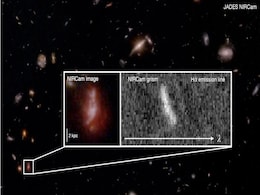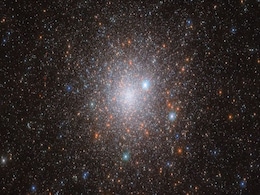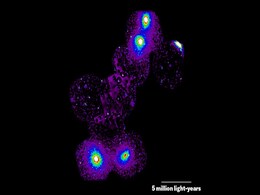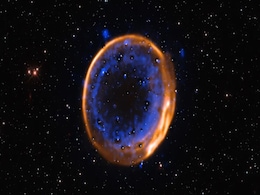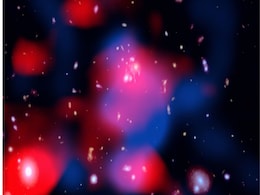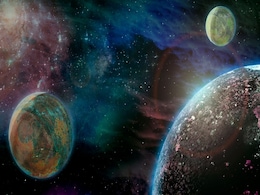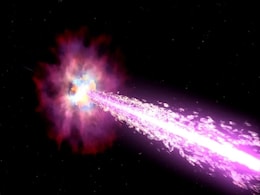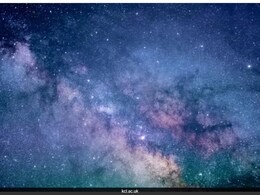Cosmic Structures
- All
- News
-

"Cosmic Creepy-Crawly": NASA Shares Stunning New Details Of Red Spider Nebula
- Thursday November 27, 2025
- Science | Edited by Srishti Singh Sisodia
The image was captured by NIRCam, Webb's primary near-infrared imager, which aims to provide high-resolution imaging and spectroscopy.
-
 www.ndtv.com
www.ndtv.com
-

James Webb Telescope May Have Spotted First Generation of Stars in the Universe
- Sunday November 16, 2025
- Written by Gadgets 360 Staff
Astronomers using JWST may have discovered Population III stars in cluster LAP1-B, offering new insights into early galaxy formation and the universe’s first luminous objects. JWST observations suggest Population III stars may have formed 13 billion years ago, helping trace early galaxies. These stars might be building blocks for larger galaxies ...
-
 www.gadgets360.com
www.gadgets360.com
-

James Webb Telescope Finds Early Universe Galaxies Were More Chaotic Than We Thought
- Thursday October 23, 2025
- Written by Gadgets 360 Staff
The James Webb Space Telescope has revealed that galaxies in the early universe were far more chaotic and unstable than once believed. A new study shows that gas turbulence and intense star formation disrupted young galaxies, reshaping scientists’ understanding of how galaxies evolved into the structured systems seen today.
-
 www.gadgets360.com
www.gadgets360.com
-

From 'Kala Ganpana' To 'Bharatiya Bijganit': UGC Draft Proposes Ancient Indian Math In UG Curriculum
- Monday August 25, 2025
- Education | Edited by Lavkesh Singh
The draft also explores cosmic time structures, from Yugas and Kalpas to "Brahma's day (Brahma Varsa)," along with cycles like "Vishnu Varsa" and "Shiva Varsa."
-
 www.ndtv.com/education
www.ndtv.com/education
-

Hubble Unveils Dark Matter Web in Stunning Abell 209 Galaxy Cluster Image
- Sunday July 20, 2025
- Written by Gadgets 360 Staff
NASA/ESA’s Hubble Space Telescope has released a stunning new image of Abell 209, a massive galaxy cluster 2.8 billion light-years away in Cetus. The golden cluster houses over 100 galaxies, but beneath them lies an invisible web of hot gas and dark matter. Using gravitational lensing, Hubble reveals curved arcs of light from background galaxies,...
-
 www.gadgets360.com
www.gadgets360.com
-

James Webb Telescope Spots Rare ‘Cosmic Owl’ Formed by Colliding Galaxies
- Monday July 14, 2025
- Written by Gadgets 360 Staff
NASA’s James Webb Space Telescope has unveiled the “Cosmic Owl,” a jaw-dropping image of two colliding ring galaxies forming a structure that resembles an owl’s face. This double-ring formation is extraordinarily rare, and the event is shedding light on galaxy evolution, black hole dynamics, and rapid star formation. Led by Ph.D. student Mi...
-
 www.gadgets360.com
www.gadgets360.com
-

Scientists Trace Universe’s Missing Ordinary Matter Using FRBs and X-rays
- Wednesday July 9, 2025
- Written by Gadgets 360 Staff
New astronomical breakthroughs have identified where the universe’s “missing” ordinary matter resides. Using 70 FRBs, including one from 9 billion light-years away, scientists discovered that 76% of ordinary matter exists between galaxies. A separate X-ray study observed an enormous hot gas filament connecting galaxy clusters.
-
 www.gadgets360.com
www.gadgets360.com
-

Astronomers Capture First-Ever Image of a Dead Star That Exploded Twice in Rare Supernova Event
- Saturday July 5, 2025
- Written by Gadgets 360 Staff
Astronomers have captured the first-ever image of a white dwarf star undergoing a rare double-detonation supernova. Using the Very Large Telescope, the team revealed that such explosions can occur without a star reaching the Chandrasekhar limit. The findings, published in Nature Astronomy, could reshape existing theories about stellar death and imp...
-
 www.gadgets360.com
www.gadgets360.com
-

Most Distant Mini-Halo Discovered in Galaxy Cluster 10 Billion Light-Years Away
- Monday June 30, 2025
- Written by Gadgets 360 Staff
Astronomers have uncovered the most distant mini-halo ever detected, located around the galaxy cluster SpARCS1049, a staggering 10 billion light-years from Earth. Using the LOFAR radio telescope network, which spans eight European countries, researchers detected a faint, diffuse glow—evidence of a giant cloud of high-energy particles and magnetic...
-
 www.gadgets360.com
www.gadgets360.com
-

Vera C. Rubin Observatory Unveils First Images, Hints at Universe’s Dynamic Secrets Ahead
- Wednesday June 25, 2025
- Written by Gadgets 360 Staff
The Rubin Observatory’s first image captures 10 million galaxies, marking the start of a decade-long sky survey. With its powerful telescope and LSST camera, it will scan the southern sky every three nights, unveiling hidden galaxies, stellar nurseries, and transient cosmic events. Scientists anticipate transformative discoveries about dark matte...
-
 www.gadgets360.com
www.gadgets360.com
-

Fast Radio Bursts Reveal Universe’s Missing Matter Hidden in Cosmic Intergalactic Fog
- Thursday June 19, 2025
- Written by Gadgets 360 Staff
Astronomers have uncovered the universe’s missing baryonic matter using rapid radio bursts. The study, published in Nature Astronomy, shows that most ordinary matter lies between galaxies, hidden in faint intergalactic clouds. This breakthrough highlights FRBs as powerful tools to probe cosmic structures, paving the way for discoveries in large-s...
-
 www.gadgets360.com
www.gadgets360.com
-

New Study Suggests Universe Will End Sooner Than Previously Thought
- Tuesday May 13, 2025
- Science | Edited by Nikhil Pandey
The universe is decaying much faster than thought. This is shown by calculations of three Dutch scientists on the so-called Hawking radiation.
-
 www.ndtv.com
www.ndtv.com
-

New Study Finds Hercules-Corona Borealis Great Wall Bigger and Nearer Than Thought
- Wednesday April 23, 2025
- Written by Gadgets 360 Staff
GRBs uncover a more massive and closer Hercules–Corona Borealis Great Wall, reshaping cosmic scale theories.Astronomers have found that the Hercules–Corona Borealis Great Wall—the largest known structure in the universe—is even larger and closer than previously thought. Spanning 10 billion light-years, this immense cluster of galaxies was t...
-
 www.gadgets360.com
www.gadgets360.com
-

Twinkling Star Reveals Hidden Plasma Structure Near Earth
- Tuesday April 22, 2025
- Science | Daniel Reardon, The Conversation
With the most powerful radio telescope in the southern hemisphere, we have observed a twinkling star and discovered an abundance of mysterious plasma structures in our cosmic neighbourhood.
-
 www.ndtv.com
www.ndtv.com
-

Did Black Hole Radiation Shape the Universe?
- Saturday March 29, 2025
- Written by Gadgets 360 Staff
A study suggests that Hawking radiation, first proposed by Stephen Hawking, may have influenced the universe’s structure. According to reports, primordial black holes that existed in the early universe could have evaporated through Hawking radiation, impacting matter distribution. The research explores how these black holes might have shaped gala...
-
 www.gadgets360.com
www.gadgets360.com
-

"Cosmic Creepy-Crawly": NASA Shares Stunning New Details Of Red Spider Nebula
- Thursday November 27, 2025
- Science | Edited by Srishti Singh Sisodia
The image was captured by NIRCam, Webb's primary near-infrared imager, which aims to provide high-resolution imaging and spectroscopy.
-
 www.ndtv.com
www.ndtv.com
-

James Webb Telescope May Have Spotted First Generation of Stars in the Universe
- Sunday November 16, 2025
- Written by Gadgets 360 Staff
Astronomers using JWST may have discovered Population III stars in cluster LAP1-B, offering new insights into early galaxy formation and the universe’s first luminous objects. JWST observations suggest Population III stars may have formed 13 billion years ago, helping trace early galaxies. These stars might be building blocks for larger galaxies ...
-
 www.gadgets360.com
www.gadgets360.com
-

James Webb Telescope Finds Early Universe Galaxies Were More Chaotic Than We Thought
- Thursday October 23, 2025
- Written by Gadgets 360 Staff
The James Webb Space Telescope has revealed that galaxies in the early universe were far more chaotic and unstable than once believed. A new study shows that gas turbulence and intense star formation disrupted young galaxies, reshaping scientists’ understanding of how galaxies evolved into the structured systems seen today.
-
 www.gadgets360.com
www.gadgets360.com
-

From 'Kala Ganpana' To 'Bharatiya Bijganit': UGC Draft Proposes Ancient Indian Math In UG Curriculum
- Monday August 25, 2025
- Education | Edited by Lavkesh Singh
The draft also explores cosmic time structures, from Yugas and Kalpas to "Brahma's day (Brahma Varsa)," along with cycles like "Vishnu Varsa" and "Shiva Varsa."
-
 www.ndtv.com/education
www.ndtv.com/education
-

Hubble Unveils Dark Matter Web in Stunning Abell 209 Galaxy Cluster Image
- Sunday July 20, 2025
- Written by Gadgets 360 Staff
NASA/ESA’s Hubble Space Telescope has released a stunning new image of Abell 209, a massive galaxy cluster 2.8 billion light-years away in Cetus. The golden cluster houses over 100 galaxies, but beneath them lies an invisible web of hot gas and dark matter. Using gravitational lensing, Hubble reveals curved arcs of light from background galaxies,...
-
 www.gadgets360.com
www.gadgets360.com
-

James Webb Telescope Spots Rare ‘Cosmic Owl’ Formed by Colliding Galaxies
- Monday July 14, 2025
- Written by Gadgets 360 Staff
NASA’s James Webb Space Telescope has unveiled the “Cosmic Owl,” a jaw-dropping image of two colliding ring galaxies forming a structure that resembles an owl’s face. This double-ring formation is extraordinarily rare, and the event is shedding light on galaxy evolution, black hole dynamics, and rapid star formation. Led by Ph.D. student Mi...
-
 www.gadgets360.com
www.gadgets360.com
-

Scientists Trace Universe’s Missing Ordinary Matter Using FRBs and X-rays
- Wednesday July 9, 2025
- Written by Gadgets 360 Staff
New astronomical breakthroughs have identified where the universe’s “missing” ordinary matter resides. Using 70 FRBs, including one from 9 billion light-years away, scientists discovered that 76% of ordinary matter exists between galaxies. A separate X-ray study observed an enormous hot gas filament connecting galaxy clusters.
-
 www.gadgets360.com
www.gadgets360.com
-

Astronomers Capture First-Ever Image of a Dead Star That Exploded Twice in Rare Supernova Event
- Saturday July 5, 2025
- Written by Gadgets 360 Staff
Astronomers have captured the first-ever image of a white dwarf star undergoing a rare double-detonation supernova. Using the Very Large Telescope, the team revealed that such explosions can occur without a star reaching the Chandrasekhar limit. The findings, published in Nature Astronomy, could reshape existing theories about stellar death and imp...
-
 www.gadgets360.com
www.gadgets360.com
-

Most Distant Mini-Halo Discovered in Galaxy Cluster 10 Billion Light-Years Away
- Monday June 30, 2025
- Written by Gadgets 360 Staff
Astronomers have uncovered the most distant mini-halo ever detected, located around the galaxy cluster SpARCS1049, a staggering 10 billion light-years from Earth. Using the LOFAR radio telescope network, which spans eight European countries, researchers detected a faint, diffuse glow—evidence of a giant cloud of high-energy particles and magnetic...
-
 www.gadgets360.com
www.gadgets360.com
-

Vera C. Rubin Observatory Unveils First Images, Hints at Universe’s Dynamic Secrets Ahead
- Wednesday June 25, 2025
- Written by Gadgets 360 Staff
The Rubin Observatory’s first image captures 10 million galaxies, marking the start of a decade-long sky survey. With its powerful telescope and LSST camera, it will scan the southern sky every three nights, unveiling hidden galaxies, stellar nurseries, and transient cosmic events. Scientists anticipate transformative discoveries about dark matte...
-
 www.gadgets360.com
www.gadgets360.com
-

Fast Radio Bursts Reveal Universe’s Missing Matter Hidden in Cosmic Intergalactic Fog
- Thursday June 19, 2025
- Written by Gadgets 360 Staff
Astronomers have uncovered the universe’s missing baryonic matter using rapid radio bursts. The study, published in Nature Astronomy, shows that most ordinary matter lies between galaxies, hidden in faint intergalactic clouds. This breakthrough highlights FRBs as powerful tools to probe cosmic structures, paving the way for discoveries in large-s...
-
 www.gadgets360.com
www.gadgets360.com
-

New Study Suggests Universe Will End Sooner Than Previously Thought
- Tuesday May 13, 2025
- Science | Edited by Nikhil Pandey
The universe is decaying much faster than thought. This is shown by calculations of three Dutch scientists on the so-called Hawking radiation.
-
 www.ndtv.com
www.ndtv.com
-

New Study Finds Hercules-Corona Borealis Great Wall Bigger and Nearer Than Thought
- Wednesday April 23, 2025
- Written by Gadgets 360 Staff
GRBs uncover a more massive and closer Hercules–Corona Borealis Great Wall, reshaping cosmic scale theories.Astronomers have found that the Hercules–Corona Borealis Great Wall—the largest known structure in the universe—is even larger and closer than previously thought. Spanning 10 billion light-years, this immense cluster of galaxies was t...
-
 www.gadgets360.com
www.gadgets360.com
-

Twinkling Star Reveals Hidden Plasma Structure Near Earth
- Tuesday April 22, 2025
- Science | Daniel Reardon, The Conversation
With the most powerful radio telescope in the southern hemisphere, we have observed a twinkling star and discovered an abundance of mysterious plasma structures in our cosmic neighbourhood.
-
 www.ndtv.com
www.ndtv.com
-

Did Black Hole Radiation Shape the Universe?
- Saturday March 29, 2025
- Written by Gadgets 360 Staff
A study suggests that Hawking radiation, first proposed by Stephen Hawking, may have influenced the universe’s structure. According to reports, primordial black holes that existed in the early universe could have evaporated through Hawking radiation, impacting matter distribution. The research explores how these black holes might have shaped gala...
-
 www.gadgets360.com
www.gadgets360.com



